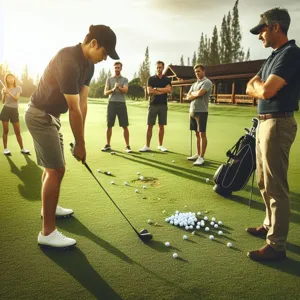Whether you’re a novice eager to break into the sport or a seasoned golfer aiming to refine your skills, effective practice is the cornerstone of improvement on the green.
Golf is as much a mental game as it is a physical one, and maximizing your practice sessions can significantly elevate your performance when it matters most. In this blog post, we’ll dive into expert tips and strategies designed to enhance your swing, improve your accuracy, and boost your confidence. From focusing on your grip and stance to incorporating drills that mimic real-course scenarios, we’ll cover everything you need to transform your practice time into a powerful tool for personal growth. Join us as we explore how to make every swing count and unlock your full potential on the golf course!
1. Understanding the Importance of Practice in Golf

Understanding the Importance of Practice in Golf
Golf is a game of precision, patience, and finesse, and practice is the cornerstone of mastery in this beloved sport. Unlike many other athletic pursuits, golf requires a delicate balance of technique, mental focus, and physical conditioning, making effective practice sessions crucial for improvement.
When you step onto the driving range or the putting green, you’re not just hitting balls; you’re honing your skills, building muscle memory, and developing a deeper understanding of your swing mechanics. Each practice session provides an invaluable opportunity to identify weaknesses and refine your strengths, allowing you to approach the course with greater confidence and clarity.
Moreover, the importance of practice extends beyond simply perfecting your swing. Golf is as much a mental game as it is a physical one. Regular practice helps you build a routine, enabling you to develop the mental fortitude required to handle the pressures of competition. By simulating on-course scenarios during practice—whether it’s hitting from the rough, working on your short game, or practicing under time constraints—you can prepare yourself for the challenges that await you during a round.
Additionally, frequent practice helps in building familiarity with your clubs and the golf course itself. Understanding how different clubs perform under various conditions allows you to make informed decisions on the course, while regular exposure to different lies and putting surfaces can enhance your adaptability on the greens.
In short, practice is not merely a means to an end; it’s an essential part of the journey to becoming a better golfer. By committing to your practice sessions and approaching them with purpose and intention, you’ll find yourself not only improving your scores but also deepening your love for the game. So, grab your clubs, make a plan, and embrace the transformative power of dedicated practice. Your future self on the course will thank you!
2. Setting Clear Goals for Your Practice Sessions
Setting clear goals for your practice sessions is essential if you want to maximize your swing and elevate your game. Just as a skilled architect wouldn’t begin construction without a blueprint, you shouldn’t step onto the driving range without a defined purpose. Having specific, measurable objectives not only gives direction to your practice but also provides a sense of accomplishment as you achieve them.
Begin by assessing your current skill level and identifying areas for improvement. Are you struggling with your driver accuracy? Looking to enhance your short game? Or perhaps you want to refine your putting skills? once you pinpoint these areas, break them down into achievable goals. For instance, instead of vaguely aiming to “hit better drives,” set a concrete target like “landing 80% of my drives within 20 yards of the fairway.”
In addition to short-term goals, consider setting long-term objectives that will keep you motivated over the season. This could range from lowering your handicap by a specific number to mastering a new club in your bag. By visualizing your success, you create a roadmap that guides each session, allowing you to focus your energy where it counts most.
Keep a practice journal to track your progress and reflect on your performance. Documenting your achievements and setbacks will help you stay accountable and adjust your goals as needed. Remember, practice is not just about repetition; it’s about intentional and focused effort. With clear goals in mind, each session becomes an opportunity to build on your skills and get one step closer to your golfing aspirations. Establish a routine, stay committed, and watch as your dedication transforms your game.
3. Creating a Structured Practice Plan

Creating a structured practice plan is essential for maximizing the benefits of your golf practice sessions. Without a clear roadmap, it’s easy to fall into the trap of aimlessly hitting balls at the driving range or working on the same few swings without any real focus. A structured plan not only enhances your efficiency but also ensures that you’re addressing specific areas of your game that need improvement.
Start by assessing your current skill level and identifying your strengths and weaknesses. Are you struggling with your short game? Is your driver consistently off-target? Once you have a clear understanding of where you stand, set specific, measurable, achievable, relevant, and time-bound (SMART) goals for your practice sessions. For instance, if you want to improve your putting, aim to reduce your three-putts per round by a certain percentage over the next month.
Next, break your practice sessions into segments that target different aspects of your game. Dedicate time to your full swing, short game, and putting, ensuring that each session has a balanced focus. For example, you might allocate 30 minutes to driving, 20 minutes to chipping, and 10 minutes to putting. Incorporate drills that challenge you and simulate on-course situations, such as practicing approach shots from various lies and distances.
Additionally, consider incorporating a warm-up routine to prepare both your body and mind for practice. Stretching and doing light exercises can help increase your flexibility and prevent injuries, setting the tone for a productive session. As you practice, keep a journal to track your progress and make notes about what works and what needs improvement. This reflection will guide your future sessions, allowing you to adapt and refine your practice plan over time.
By creating a structured practice plan, you’ll not only enhance your skills but also foster a sense of purpose and direction in your training. Embrace the discipline of a well-organized approach, and watch as your game evolves, turning your practice sessions into powerful tools for improvement.
4. Focusing on Fundamentals: Grip, Stance, and Posture
Focusing on fundamentals is essential for anyone looking to get the most out of their golf practice sessions. While it can be tempting to dive straight into perfecting your swing or trying out new clubs, neglecting the foundational elements of grip, stance, and posture can hinder your progress and lead to bad habits down the line.
**Grip:** The way you hold the club is your first point of contact with the ball, and it plays a crucial role in shot accuracy and distance. A proper grip allows for better control and consistency. Experiment with different grips—whether it’s the interlocking grip, overlapping grip, or the baseball grip—to find what feels most comfortable for you. Ensure that your grip pressure is firm but relaxed; gripping too tightly can lead to tension in your arms and hands, affecting your swing.
**Stance:** Your stance sets the stage for a successful swing. Stand with your feet shoulder-width apart, and distribute your weight evenly on both legs. A balanced stance allows for better stability and power. Pay attention to the positioning of your knees; they should be slightly flexed to promote a more athletic posture. Additionally, consider the ball position relative to your feet, as this can influence the trajectory and direction of your shots.
**Posture:** The way you position your body can greatly influence your performance. Stand tall with a straight back and slight bend at the hips, allowing your arms to hang naturally. Your head should be down, eyes focused on the ball, but avoid straining your neck by keeping your shoulders relaxed. Good posture not only enhances your swing mechanics but also helps to prevent injuries over time.
By dedicating time to refine these fundamental aspects of your game during practice, you’ll find that your overall performance improves significantly. The key is consistency; incorporate drills that emphasize grip, stance, and posture in your practice routine. With a solid foundation, you’ll be well on your way to maximizing your swing and, ultimately, your enjoyment of the game.
5. Incorporating Drills to Improve Swing Mechanics

Incorporating drills into your practice routine is a game-changer when it comes to honing your swing mechanics. These targeted exercises can help you focus on specific aspects of your swing, enabling you to build muscle memory and develop a more consistent, powerful stroke. Whether you’re a seasoned golfer or a weekend warrior, integrating drills into your sessions will yield impressive results on the course.
Start with the basics by working on your grip and posture, ensuring that you’re set up correctly before even taking your first swing. Once you’re comfortable, move on to specific drills that isolate key elements of your swing. For instance, the “One-Handed Drill” is a fantastic way to improve your wrist hinge and follow-through. By practicing your swing with just one hand at a time, you can develop greater control and understand the mechanics of your swing without the added complexity of using both hands.
Another effective drill is the “Feet-Together Drill,” which encourages balance and stability. By taking your stance with your feet together, you’ll be forced to engage your core and maintain your balance throughout the swing, helping to eliminate unnecessary movements that can lead to inconsistency.
Don’t forget about visualization techniques as well. Spend a few moments imagining the perfect swing before you take your shot. This mental practice can reinforce the physical movements you’re aiming to achieve and enhance your focus during play.
Finally, consider recording your swings with a smartphone or camera. Watching your form in slow motion can highlight areas for improvement that you might not notice in real time. Analyzing your mechanics visually allows you to make immediate adjustments during your practice sessions.
By incorporating these drills into your routine, you’ll not only improve your swing mechanics but also foster a deeper understanding of your golf game. Consistent practice with purpose will ultimately lead to more enjoyable rounds on the course and lower scores.
6. Utilizing Technology: Swing Analyzers and Apps
In the modern era of golf, technology has transformed the way players approach their practice sessions. Utilizing swing analyzers and golf apps can provide a level of insight that traditional methods simply can’t match. These tools offer real-time feedback and detailed analysis of your swing mechanics, allowing you to pinpoint areas for improvement with unprecedented precision.
Swing analyzers, for instance, come equipped with sensors that attach to your club or glove, capturing data on various metrics such as swing speed, angle, and tempo. Some models even provide 3D visualizations of your swing, allowing you to see your form from different angles. This visual feedback can be invaluable, helping you to make immediate adjustments to your technique and build muscle memory more effectively.
In addition to swing analyzers, golf apps have become indispensable companions for golfers at all levels. These apps often include features such as shot tracking, GPS yardage, and personalized coaching tips based on your performance data. By logging your practice sessions and rounds, you can identify patterns in your game—such as consistent miss-hits or struggling on specific holes—and tailor your practice to address these weaknesses.
Moreover, many apps integrate with social features, enabling you to connect with other golfers, share your progress, and even participate in challenges. This not only adds a fun, competitive element to your practice but also fosters a sense of community among fellow golf enthusiasts.
By incorporating technology into your practice routine, you can maximize your swing efficiency and ultimately enhance your overall performance on the course. So, whether you’re a seasoned pro or a weekend warrior, consider adding a swing analyzer or golf app to your toolkit, and watch your game reach new heights.
7. The Role of Mental Training in Golf Practice

While physical skills are undeniably essential in golf, the mental aspect of the game often separates the good players from the great ones. Mental training is a critical component of your practice sessions, yet it is frequently overlooked. Golf is as much a mental challenge as it is a physical one. The ability to maintain focus, manage stress, and cultivate a positive mindset can dramatically enhance your performance on the course.
To incorporate mental training into your practice routine, start by setting clear, achievable goals for each session. Whether it’s improving your putting technique or perfecting your drive, having a specific focus allows you to channel your mental energy effectively. Visualization techniques can also be incredibly beneficial. Before each swing, take a moment to close your eyes and visualize the ideal shot. Imagine the ball soaring through the air and landing exactly where you want it to. This practice not only builds confidence but also helps to create muscle memory.
Another key aspect of mental training is developing a pre-shot routine. This ritual can help you enter a focused, relaxed state before each shot. It may involve deep breathing, aligning your stance, or repeating a positive affirmation. Consistency in your pre-shot routine fosters a sense of calm and reduces anxiety, allowing you to perform at your best under pressure.
Finally, don’t underestimate the power of mindfulness. Staying present during your practice sessions—being aware of your thoughts and feelings without judgment—can enhance your concentration and improve your overall game. By integrating these mental strategies into your golf practice, you’ll not only sharpen your skills but also build the resilience needed to tackle the mental challenges that arise on the course. In doing so, you’ll maximize your swing and elevate your golfing experience to new heights.
8. Practicing with Purpose: Quality Over Quantity
When it comes to golf practice, the age-old adage “quality over quantity” rings especially true. Many players fall into the trap of spending countless hours on the driving range, mindlessly hitting ball after ball without a clear focus. While repetition is essential for muscle memory, practicing without purpose can lead to developing bad habits and frustration rather than improvement.
To truly maximize your practice sessions, take a step back and define specific goals for each outing. Instead of merely aiming to hit a large number of balls, concentrate on one or two aspects of your game that need improvement—be it your grip, stance, swing mechanics, or putting technique. For instance, if you notice a tendency to slice your drives, dedicate a practice session to addressing grip and alignment adjustments. Focus on making intentional swings that reinforce these changes, and take the time to reflect on each shot.
Visualization plays a crucial role in purposeful practice as well. Picture the perfect shot before you take it, envisioning the trajectory, distance, and landing spot. This mental preparation not only sharpens your focus but also helps build confidence in your abilities.
Moreover, consider incorporating drills into your routine that offer targeted feedback. Whether it’s using alignment sticks to ensure proper setup or practicing with a mirror to check your stance, these tools can help you refine your technique and track your progress. As you practice, take notes on what works and what doesn’t, allowing you to adjust your focus for future sessions.
Ultimately, the key to effective practice lies in being intentional about your efforts. By prioritizing quality over quantity, you’ll cultivate a deeper understanding of your game and see tangible improvements in your performance on the course. Remember, every swing should have a purpose, and each session should leave you feeling more skilled and confident as you approach the next round.
9. Incorporating Short Game Practice: Putting and Chipping
When it comes to golf, many players tend to focus primarily on their drives and long-range shots, often neglecting the crucial aspects of their short game. However, incorporating short game practice—particularly putting and chipping—can dramatically enhance your overall performance on the course. These skills are not just supplementary; they can be the difference between a good round and a great one.
Start with putting, as it is arguably the most essential component of the short game. Set up a dedicated practice area where you can work on different distances and angles. Use alignment aids, such as a string or chalk line, to ensure your stance and stroke are consistent. Spend time mastering the art of distance control; practice hitting putts to various markers to develop a feel for how hard to strike the ball. Remember, it’s not just about sinking the putt, but also about leaving yourself in a good position for the next shot if you miss.
Chipping, on the other hand, requires a different mindset and technique. Find a practice green or a chipping area where you can work on various lies and slopes. Experiment with different clubs—from pitching wedges to 7-irons—to understand how each affects the ball’s trajectory and roll. Focus on your grip, stance, and swing path, and try to visualize the landing spot for each chip shot. Setting up targets can help you refine your aim and consistency.
Additionally, incorporate drills that mimic on-course scenarios. For instance, practice chipping from uneven lies or putting from different breaks, as these are situations you’ll encounter during a round. By dedicating time to your short game, you will not only improve your scoring potential but also gain the confidence to manage tricky situations on the course. Remember, in golf, it’s often said that “you drive for show, but you putt for dough.” So, make the short game a priority in your practice sessions and watch your scores drop as your skills improve.
10. Simulation of Course Conditions During Practice
When it comes to honing your golf skills, replicating real course conditions during practice can be a game-changer. Simply hitting balls on the driving range or putting on a flat green, while beneficial, won’t fully prepare you for the unique challenges and nuances of an actual golf course. To maximize your practice sessions, focus on creating a realistic simulation that mirrors the environments you’ll encounter on the course.
Start by incorporating various lies and uneven surfaces into your practice routine. Set up practice stations that mimic the slopes, roughs, and bunkers you might face. For example, practice hitting from a downhill lie by placing a tee on a lower surface or find a sloped area in your local park. This will help you develop the necessary skills to adapt your stance and swing to less-than-ideal situations.
Additionally, pay attention to your practice environment. If possible, choose a driving range with different target distances and obstacles to simulate the visual challenges of a course. Take the time to practice shots over water or around trees, as this will prepare you mentally for the strategic decision-making required on the course.
Moreover, don’t forget to work on your short game under pressure. Set up scenarios where you have to make a crucial putt or chip, mimicking the pressure of a tournament or that final hole. You can even invite friends for a friendly competition to add an element of realism and urgency to your practice.
By simulating course conditions, you’ll not only enhance your technical skills but also improve your mental game, making you a more versatile and confident player. The next time you step onto the course, you’ll feel more prepared to tackle whatever challenges come your way, allowing you to maximize your swing and your overall performance.
11. Staying Physically Fit: Exercises to Enhance Your Game
Staying physically fit is crucial for any golfer looking to maximize their performance on the course. Golf may not be an intense cardio workout, but it demands a unique blend of strength, flexibility, balance, and endurance. Incorporating specific exercises into your routine can significantly enhance your game and help you achieve that perfect swing.
**Strength Training:** Developing core strength is vital for generating power in your swing. Exercises like planks, medicine ball twists, and rotational cable exercises can help build the abdominal and lower back strength needed for stability during your swing. Strong legs are equally important; squats and lunges will not only improve your balance but also give you the explosive power needed as you drive off the tee.
**Flexibility Work:** Flexibility plays an integral role in achieving a full, unrestricted swing. Incorporate stretching routines that focus on the shoulders, hips, and back to ensure you can achieve a full range of motion. Yoga is an excellent way to improve flexibility and balance while also providing mental clarity that can enhance your focus on the course.
**Cardiovascular Fitness:** While golf is often seen as a leisurely sport, walking the course can be quite the workout. Incorporating cardiovascular exercises into your routine—such as brisk walking, cycling, or even swimming—will boost your stamina, allowing you to maintain energy levels throughout your round. This can be particularly beneficial in the later holes when fatigue often sets in.
**Balance Exercises:** Golf requires a tremendous amount of balance throughout your swing. Incorporate exercises like single-leg stands, balance boards, or even tai chi to enhance your stability. Improved balance will not only help you maintain your posture during your swing but also allow for better weight transfer, ultimately leading to more consistent shots.
By integrating these exercises into your fitness regimen, you will not only enhance your physical capabilities but also improve your overall golfing performance. Remember, a fitter you translates to a more powerful swing, better focus, and an overall more enjoyable experience on the course. So, lace up those sneakers and get ready to swing your way to success!
12. Keeping a Practice Journal: Tracking Progress and Insights
Keeping a practice journal is one of the most effective yet often overlooked strategies for golfers aiming to maximize their practice sessions. Think of it as your personal coaching tool, allowing you to document not just your scores and swing mechanics, but also your thoughts, feelings, and insights during each session. By consistently jotting down details about your practice, you create a roadmap of your journey, making it easier to identify patterns, set goals, and track your progress over time.
Start by noting the date and duration of each practice session, then delve into specifics—what drills you focused on, which clubs you used, and any new techniques you experimented with. Did you struggle with your short game today? Note it down and reflect on what might have caused that difficulty. Perhaps you were feeling rushed or distracted. Understanding the context of your performance can be just as important as the numbers themselves.
Additionally, a practice journal allows you to celebrate your victories, no matter how small. Did you finally nail that challenging chip shot or improve your putting accuracy? Documenting these achievements not only reinforces positive behavior but also boosts your confidence for future sessions. Over time, as you flip back through your entries, you’ll begin to see how far you’ve come, which can be incredibly motivating.
Moreover, consider including insights from your golf lessons or tips gleaned from watching professional golfers. This can enhance your learning experience and give you a broader perspective on your game. Your practice journal becomes a personalized playbook, rich with information that can guide you as you refine your skills.
In essence, keeping a practice journal is about more than just recording information; it’s a commitment to your growth as a golfer. By reflecting on your practice sessions, you can make informed adjustments, stay engaged, and ultimately maximize your swing on the course.
13. Learning from Mistakes: The Art of Reflection
Reflection is an often-overlooked component of improvement in golf, yet it holds the key to elevating your practice sessions from mundane to transformative. After each round or practice session, take a moment to step back and review your performance. What worked well? What didn’t? This process of self-analysis allows you to identify specific areas that need attention, turning mistakes into valuable learning opportunities.
Consider keeping a golf journal to document your thoughts and experiences on the course. Note down the shots that went awry, the swings that felt particularly good, and any patterns you observe in your performance. This written record can serve as a powerful tool for tracking your progress over time and pinpointing recurring issues that may be affecting your game.
Additionally, don’t shy away from discussing your play with a coach or fellow golfers. Engaging in dialogue about your mistakes can provide new perspectives and insights that you may not have considered. They might offer tips or techniques that have worked for them, enriching your understanding of the game.
When reflecting on your mistakes, approach the process with a constructive mindset. Instead of dwelling on failures, focus on how those moments can inform your future practice. For example, if you consistently struggle with your short game, dedicate specific practice time to chipping and putting drills. Embracing this mindset of continuous learning will not only improve your skills but also enhance your enjoyment of the game.
In summary, learning from your mistakes is an art that requires patience and honesty. By taking the time to reflect on your performance and adjusting your practice accordingly, you’ll not only maximize the effectiveness of your sessions but also cultivate a deeper appreciation for the journey of becoming a better golfer. Remember, every swing is a lesson, and every lesson brings you closer to your goals on the course.
14. Joining a Golf Community for Support and Motivation
Joining a golf community can be a game-changer for your practice sessions, providing not just support but also a wealth of motivation that can propel your skills to new heights. Golf, often seen as an individual sport, flourishes when shared with others who share your passion. Whether it’s a local club, an online forum, or a casual group of friends who hit the course together, being part of a golf community creates a sense of belonging and accountability that can significantly enhance your practice experience.
Imagine stepping onto the driving range surrounded by fellow enthusiasts, each one fervently working on their swings. The atmosphere is electric, filled with laughter, encouragement, and the sound of club against ball. This camaraderie not only makes practice more enjoyable but also pushes you to improve. When you see your peers honing their skills, it inspires you to elevate your own game. You may find yourself trying that new technique your friend has been raving about or picking up tips from a seasoned golfer who’s willing to share their expertise.
In addition to providing motivation, a golf community offers a platform for sharing advice and resources. You can exchange insights on the latest training aids, review equipment, or discuss strategies to tackle specific courses. Many communities host events, friendly competitions, or group outings that can add excitement and a sense of purpose to your practice. Plus, the opportunity to celebrate each other’s achievements, big or small, fosters a positive environment that can be hard to find when practicing solo.
Remember, golf can be as much about the journey as it is about the scorecard. By surrounding yourself with like-minded individuals who share your love for the game, you’ll not only enhance your skills but also build lasting friendships. So, seek out a golf community—whether it’s through social media groups, local clubs, or golf events—and watch how your practice sessions transform into a more dynamic and rewarding experience. With the support and motivation of fellow golfers, you’ll be more inspired than ever to maximize your swing and enjoy every moment on the course.
15. When to Seek Professional Coaching for Improvement
Knowing when to seek professional coaching can be the turning point in your golfing journey. While practicing on your own is essential for honing your skills, there comes a time when the insights of a seasoned coach can significantly enhance your game. If you find yourself plateauing, struggling with consistency, or unable to identify specific areas for improvement, it’s a clear sign that professional guidance may be beneficial.
A golf coach can provide personalized feedback tailored to your unique swing mechanics and playing style. They can help you uncover the subtle nuances that often go unnoticed during solo practice sessions. For instance, a coach might identify flaws in your grip or stance that are affecting your swing path or trajectory, insights that can save you countless hours of ineffective practice.
Moreover, if you’re preparing for a tournament or looking to lower your handicap, structured lessons will instill a sense of accountability and discipline in your practice routines. Coaches can design a targeted practice plan that focuses on your weaknesses while reinforcing your strengths. They can also introduce you to drills that challenge you beyond your comfort zone, pushing you toward greater achievement.
Don’t forget the psychological aspect of the game—professional coaching can help you develop the mental resilience necessary for competitive play. Whether it’s handling pressure during a crucial putt or maintaining focus throughout your round, a coach will equip you with strategies to enhance your mental game.
In sum, if you aspire to elevate your golf skills and truly maximize the benefits of your practice sessions, consider investing in professional coaching. It’s a strategic decision that can lead to significant improvements, transforming your golfing experience from frustrating to fulfilling.
As we wrap up our discussion on maximizing your swing during practice sessions, we hope you feel empowered to take your golf game to the next level. By incorporating these tips into your routine—whether it’s refining your stance, focusing on your grip, or setting specific goals for each session—you can transform your practice time into a powerful tool for improvement. Remember, consistency is key, and every minute spent honing your skills brings you closer to mastering that perfect swing. So grab your clubs, hit the driving range, and enjoy the journey of becoming the golfer you aspire to be. Happy swinging!




































